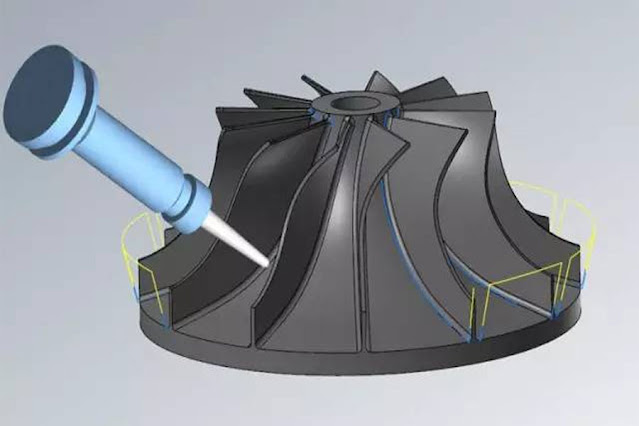Compared with the machining of the bottom edge of the tool, the side edge machining can obtain a smoother machining surface by using the tool side edge machining. It is suitable for the finishing of complex cavity workpieces in the aerospace industry.
Mastercam provides special functions to effectively prevent overcutting at the bottom of the tool and part cavity. It can program the side edge machining according to the surface or wire frame data, and can choose a variety of types of tools including tapered knives.Five-axis linkage for efficient roughing
Mastercam's five-axis linkage roughing adopts fully automatic tool axis control mode to avoid sharp changes in the tool axis during roughing.
Use three-axis toolpath to edit five-axis toolpath
For some workpieces, we can program a three-axis tool path first:
Then it can be converted into a five-axis toolpath in the multi-axis module of Mastercam.
The new five-axis toolpath can automatically produce tool axes and re-optimize the original toolpath data, and include complete five-axis collision detection.
Use "three-axis to five-axis" to simplify the difficulty of five-axis programming and increase the programming speed. This function supports the conversion of all three-axis toolpaths, and the generated five-axis toolpaths are fast, safe and reliable, without the worry of over-cutting.
The knife axis automatically avoids
In five-axis programming, we often have to consider the interference between the tool axis and the workpiece in the tool path.
When using Mastercam for five-axis programming, we can set to automatically adjust the forward and roll angles of the tool axis, and automatically tilt the tool axis according to the specified tolerance in the area of possible collision to avoid collision; after cutting through the collision area, it will automatically The tool axis is adjusted back to the original set angle, so as to avoid the collision between the tool and the workpiece.
In this way, is it easier to make five-axis toolpaths?
Tool cutting point control
Tool cutting point control can ensure that the cutting point of the tool is in contact with the surface of the part without changing any parameters to avoid cutting traps.
Mastercam can regulate and control the feed speed between designated areas, designated connections or section connections, and finally make the tool path cut into the workpiece more smoothly.
Tool path point distribution optimization
Optimized tool path point distribution, which can control the number of cutting nodes on each tool path. Combined with the excellent big data processing capabilities of advanced machine tools, in Mastercam we can increase the number of cutting nodes in the tool path and control the distribution of cutting points.
Increasing the number of cutting nodes in the tool path can make the distribution of the tool path points more uniform, make the movement of the tool axis during the five-axis machining process smoother, and reduce the vibration during the machining process.
This means:
Further improvement of finishing surface quality;
Stable tool load and slow tool wear speed;
Stable processing, the machine tool maintains high-precision operation.





